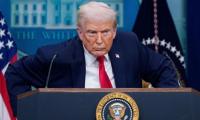Rupee rebounds against dollar in interbank market
KARACHI: Pakistani rupee rose by 0.46 percent or 1.28 rupees against dollar in the interbank market on Monday as exporters sold US currency; however, analysts expect the local unit to trade range-bound in the days ahead.
At the close of the trade, the rupee was at 275.30 per dollar, stronger than its previous close of 276.58. “Lesser payments today, more selling by exporters resulting in a decline in the rupee/dollar parity,” said Samiullah Tariq, the head of research at Pak-Kuwait Investment Company.
In the coming sessions, Tariq expects the currency to trade in a range-bound manner. The rupee ended unchanged at 283 to the dollar in the open market. After Prime Minister Shehbaz Sharif commented that the International Monetary Fund (IMF) was giving Pakistan “a terrible time” in ongoing negotiations, the rupee fell to a record low against the dollar on Friday.
The last phase of IMF talks has begun. The technical discussions ended on Monday, with the policy level discussions scheduled to start on Tuesday. The government’s ideas and suggestions have been deemed insufficient. The IMF has already released its nine tables on several topics, including the economy, fiscal, energy, and gross financing requirement.
The government’s only choice is to accept the IMF numbers because all other alternatives have been explored. The IMF is aware that it is the only entity that can help Pakistan avoid default.
As the IMF has suggested either raising the general sales tax (GST) by 1 percent or imposing a 17 percent GST on petroleum products, some new IMF recommendations have surfaced. The subsidy for lifeline consumers with less than 300 units will be cut back, and concessions to sectors focused on exports will be removed.
The tranche will be approved at an IMF executive board meeting in March when
the IMF's recommendations have been followed. The currency market should monitor changes to the IMF programme to get a sense of the rupee’s future course, according to analysts.
Currently, Pakistan’s central bank has $3.09 billion in foreign reserves, which is enough to pay for imports for less than three weeks. One of the main lending requirements established by the IMF to unlock its financing was that Pakistan removes the artificial ceiling on the rupee in order to switch to the market-based exchange rate. This was done last week.
Additionally, it raised the price of petrol, blaming the surge in global energy prices. The central bank raised interest rates last month by 100 basis points to 17 percent in a bid to combat record-high inflation.
-
 Alexander Skarsgard Breaks Silence On Rumors He Is Bisexual
Alexander Skarsgard Breaks Silence On Rumors He Is Bisexual -
 King Charles Faces Rift With Prince William Over Prince Harry’s Invictus Games
King Charles Faces Rift With Prince William Over Prince Harry’s Invictus Games -
 Elon Musk’s Critique On ChatGPT Safety Draws Sharp Response From Sam Altman
Elon Musk’s Critique On ChatGPT Safety Draws Sharp Response From Sam Altman -
 Katherine Ryan Takes Aim At Brooklyn Beckham In Fierce Defense Of His Parents
Katherine Ryan Takes Aim At Brooklyn Beckham In Fierce Defense Of His Parents -
 How Timothy Busfield, Melissa Gilbert Really Feel After Release From Jail
How Timothy Busfield, Melissa Gilbert Really Feel After Release From Jail -
 OpenAI, Bill Gates Launch ‘Horizon 1000’ To Transform AI Healthcare In Africa
OpenAI, Bill Gates Launch ‘Horizon 1000’ To Transform AI Healthcare In Africa -
 Prince Harry Receives Praises For Exposing Dark Side Of British Tabloids
Prince Harry Receives Praises For Exposing Dark Side Of British Tabloids -
 Andrew Forces Beatrice, Eugenie To Lose $60 Million Safety Net Saved For Retirement
Andrew Forces Beatrice, Eugenie To Lose $60 Million Safety Net Saved For Retirement -
 Nvidia CEO Jensen Huang To Visit China To Push Re-entry Into AI Chip Market
Nvidia CEO Jensen Huang To Visit China To Push Re-entry Into AI Chip Market -
 U.S. On Verge Of Losing Measles-free Title Due To Outbreak
U.S. On Verge Of Losing Measles-free Title Due To Outbreak -
 Harry Styles Excites Fans As He Announces Release Date Of New Song
Harry Styles Excites Fans As He Announces Release Date Of New Song -
 Japan’s Ex-PM Shinzo Abe’s Killer Is Set To Be Sentenced: How Much Punishment Could He Face?
Japan’s Ex-PM Shinzo Abe’s Killer Is Set To Be Sentenced: How Much Punishment Could He Face? -
 Prince Harry, Meghan Markle’s Return To UK Could Create Royal Family Dilemma
Prince Harry, Meghan Markle’s Return To UK Could Create Royal Family Dilemma -
 Prince Harry Turns Troubled With No Sense Of Home: ‘Isolation Is Getting To Him Mentally’
Prince Harry Turns Troubled With No Sense Of Home: ‘Isolation Is Getting To Him Mentally’ -
 Vitamin D Link To Respiratory Diseases Will Shock You
Vitamin D Link To Respiratory Diseases Will Shock You -
 A$AP Rocky Gives His Take On Children's Budding Personalities
A$AP Rocky Gives His Take On Children's Budding Personalities



